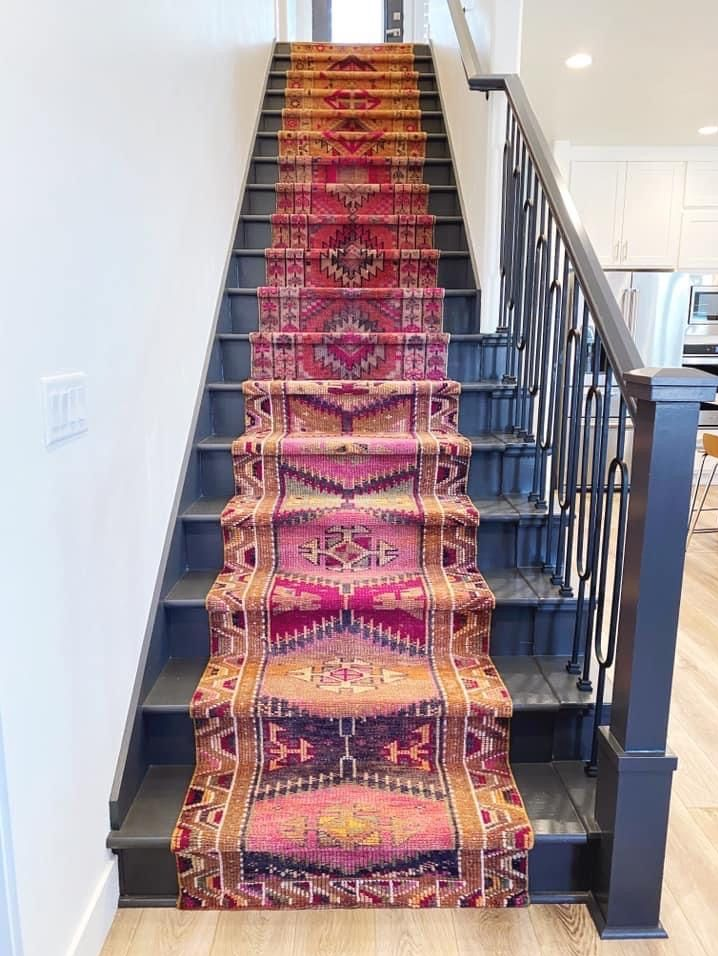
Add that Wow Factor to Your Staircase with a Vintage Runner
Share
Vintage rug stair runners are a thing! And I’m so into them. This area of your home can often be forgotten when it comes to style so I think this technique can be a great way to add a unique touch to your home. Check out some lovely examples below.
So now that you know that you want to do this in your home, let me fill you in on a few tips and tricks.
1. How many rugs should you use?
The answer is whatever makes sense for your space. Depending on the length of your staircase, you may only want one rug. One long rug can provide all that is needed to complete your aesthetic. However, if you want to have a lot of fun with it, I suggest mixing it up. This can be in the form of three rugs (one main rug through the middle and a rug on each end) or maybe even multiple minis to really enhance an eclectic sort of vibe. It’s up to you!
2. What width should I use?
You can choose rugs that span the whole width of your stairs or maybe use shorter width rugs so that you have a couple inches of exposed wood stair showing on each side. If you elect to keep a portion of your stairs exposed, I would recommend finding rugs that are already approximately the desired width versus having to cut each rug to the width you want. If you have to cut them, then you will most likely need to also bind the sides. If you have to bind, then I definitely recommend seeking out the assistance of a professional.
3. What length should I calculate for?
You will need to measure the entire length of your staircase and to do that, you should measure the rise and run of each stair and then add them up for the total length. I personally think that it’s a good idea to measure each individual stair because they may vary slightly. Also if you have a radius for the edge of each one, you will need to account for that, too. After you add all of your measurements up, I recommend adding an additional 20% for your total length needed, just in case you need it due to miscalculations and inconsistencies in the rug(s) that you may need to adjust for. Better safe than sorry!
4. Where do I start and end my runner?
I recommend starting at the bottom of the rise of the first step and ending at the top of the rise of the last step. However, a fun technique might be to add a few feet at the bottom of your staircase and a few feet at the end.
5. What kind of rugs should I use?
Persian, Afghan and Turkish rugs are good choices. They are super durable and also offer a good textural experience that can hold up to wear and tear. I do not recommend shaggy Moroccan rugs in this application. My most recent favorites to use are Herki rugs. They have sort of a nubby, thicker weave and can therefore provide a stable non-slippery surface, which also looks super cool. The rugs used in the picture below are Herki rugs.
6. Where can I get rugs to use for my stair runner?
At Velvet & Shag, of course! While we do consistently have runner rugs available in the shop, our Rug Sourcing Concierge Service is perfect for finding exactly what you need for your home specifically. Click here for more information about the service.
7. What if I’m afraid to DIY my stair runner?
While there are quite a few instructional videos that you can find online to assist you in doing it yourself, you certainly don’t have to. There are professionals who can help! Just contact a carpeting contractor near you for more information.
So have I convinced you to try a vintage rug stair runner in your home? If not, click here to check out my Pinterest board that’s solely dedicated to vintage rug stair runners and then tell me you don’t want one, too. 😁





